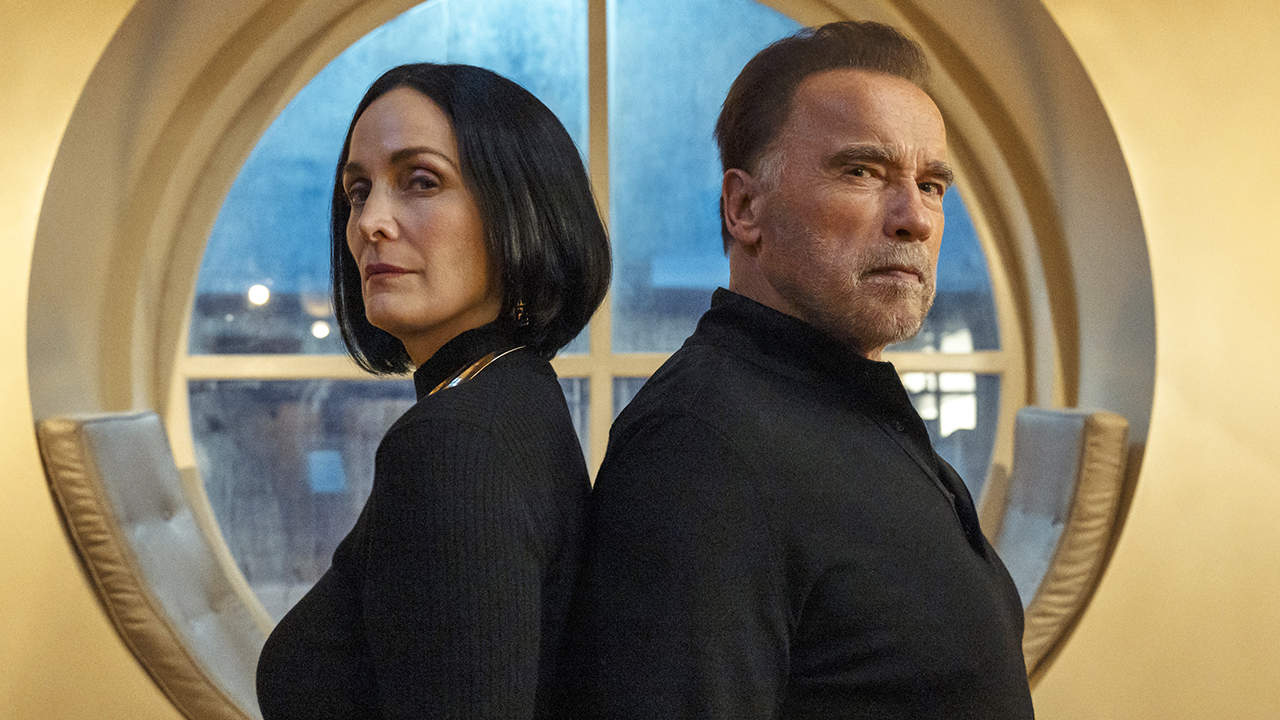
Fubar. (L to R) Carrie-Anne Moss as Greta Nelso, Arnold Schwarzenegger as Luke Brunner in episode 203 of Fubar. Cr. Christos Kalohoridis/Netflix © 2025
Last week, FUBAR returned after a 25-month wait since its initial launch on Netflix, and it bombed. Hard. By our count, it has lost 80% of its viewership. While there are probably several contributing to audiences leaving shows, the length of time we have to wait for shows to return has become increasingly noticeable in recent years and while there are circumstances outside of Netflix’s control, keeping with the status quo is going to result in more canceled shows and contribute to Netflix’s growing library of unfinished titles.
Why are we having to wait so long? What impact is it having on shows? How long do Netflix shows take to come back?
How long is it taking for shows to come back?
Examining returning shows from the past year, we’ve determined that the average time it takes for a Netflix Original scripted English-language live-action series is just over 20 months, which is approximately two years (see the table below for more details).
| Show | Previous Season Premiere | Current Season Premiere | Gap |
|---|---|---|---|
| FUBAR S2 | May 25, 2023 | June 12, 2025 | 25 mo |
| Tires S2 | May 23, 2024 | June 5, 2025 | 13 mo |
| Ginny & Georgia S3 | Jan 5, 2023 | Jun 5, 2025 | 29 mo |
| You S5 | May 2023 | Apr 24, 2025 | 24 mo |
| XO, Kitty S2 | May 18, 2023 | Jan 16, 2025 | 20 mo |
| Survival of the Thickest S2 | Jul 13, 2023 | Mar 27, 2025 | 20 mo |
| Sweet Magnolias S4 | Jul 20, 2023 | Feb 6, 2025 | 19 mo |
| The Night Agent S2 | Mar 23, 2023 | Jan 23, 2025 | 22 mo |
| The Recruit S2 | Dec 16, 2022 | Jan 30, 2025 | 25 mo |
| Mo S2 | Jan 2023 | Jan 30, 2025 | 24 mo |
| The Upshaws Part 6 | Apr 18, 2024 | Jan 9, 2025 | 9 mo |
| Cobra Kai S6 | Sep 9, 2022 | Jul 18, 2024 | 22 mo |
| Vikings: Valhalla S3 | Jan 12, 2023 | Jul 11, 2024 | 18 mo |
| Outer Banks S4 | Feb 23, 2023 | Oct 10, 2024 | 20 mo |
| The Diplomat S2 | Apr 20, 2023 | Oct 31, 2024 | 18 mo |
| The Lincoln Lawyer S3 | Jul 6, 2023 | Oct 17, 2024 | 15 mo |
| Emily in Paris S4 | Dec 1, 2022 | Aug 15, 2024 | 20 mo |
| The Umbrella Academy S4 | Jun 2022 | Aug 8, 2024 | 26 mo |
| That ’90s Show S2 | Jan 19, 2023 | Jun 27, 2024 | 17 mo |
| Monsters S2 | Jan 2022 | Sep 19, 2024 | 32 mo |
| Virgin River S6 | Aug 9, 2023 | Dec 19, 2024 | 16 mo |
| Average Gap | ≈20.7 mo (~1 yr, 8 mo) | ||
We’ve purposely excluded animation here, given that seasons are often ordered upfront, such as Tomb Raider, which was always planned to have two seasons. Although when they’re not initially planned and are given renewals, as seen in Blood of Zeus and eventually Blue Eye Samurai, they too take an extraordinary amount of time to return, with Blood of Zeus taking almost four years to return to our screens. In the case of that show, the series lost all momentum by the release of Season 2 and wasn’t granted a fourth-season renewal.
The Impact of Waiting So Long
The Recruit, That ’90s Show, and now FUBAR are the obvious biggest casualties of this prolonged waiting, given that their viewership fell off a cliff between seasons 1 and 2 and were swiftly canceled (well, FUBAR hasn’t been just yet, but it’s coming). These shows may not have had a strong enough hook to reel people in initially, and when you make them wait nearly two years, people lose all bearing on the plotline and any emotional investment in the show.
As we reported earlier this year, the impact of shows returning after such a long period means that viewership has likely shifted. Out of all the returning 2024 shows, Netflix’s viewership data suggest that only one show grew its audience: Bridgerton, which rose 13% from season 2 to 3. The majority of other returning shows weren’t so lucky:
- The Lincoln Lawyer – Slightly up
- Heartbreak High – Down 3%
- Virgin River – Down 6%
- Emily in Paris – Down 9%
- Outer Banks – Down 15%
- Cobra Kai – Down 26%
- Sweet Tooth – Down 26%
- Vikings: Valhalla – Down 29%
- Heartstopper – Down 30%
- The Umbrella Academy – Down 36%
- The Diplomat – Down 37%
- That ’90s Show – Down 79% (!)
The Lincoln Lawyer and Bridgerton appear to be exceptions to the rule mentioned in that article, both of which are the biggest shows on Netflix (top 20%), so for every other show, you’re essentially hoping that you’ve not lost too much audience and praying you get a thumbs up for more.
Some major tests are coming up to gauge people’s tolerance for waiting. Stranger Things will have a 40-month gap between Season 4, Volume 2 and Season 5, Volume 1 (approximately 3 years and 4 months), but given that it really is one of Netflix’s biggest shows in its roster, we suspect that won’t matter too much. As we’ll come onto though, Stranger Things prolonged waits between its last few seasons have not entirely been its fault…
Other big tests coming up are whether Wednesday and One Piece can achieve the same success as their first seasons, given the length of time they’ve taken to return.
Why do shows take so long to come back?
Unlike the “good old cable days” when shows returned reliably every year with 20+ episodes, today’s landscape often leaves us with just 6-10 episodes followed by agonizingly long waits. This problem isn’t limited to Netflix by any means, but it is a problem with the current makeup of scripted shows.
So, why do these shows take so long to come back?
There are a bunch of reasons why shows take longer. For one, they’re more complex than the network fare of 20 years ago, with bigger casts and more complex visual effects. Then add to the fact that post-production is now a lot longer, given that Netflix is having to dub each show for dozens of regions in addition to prepping subtitles.
This brings us to another critical challenge: actor availability. Because streaming seasons are typically much shorter, actors are rarely booked exclusively for one project year-round, like they used to be. This means an actor might film a Netflix show for six months, then immediately jump to a movie or another series for the latter half of the year. Coordinating their return for a subsequent season of the Netflix show then becomes a complex puzzle, dependent on their demanding external schedules. Now, multiply this logistical nightmare across an entire ensemble cast, and the true extent of the scheduling ‘mess’, and the resultant delays become clear.
Of course, we can’t discuss shows returning over the past five years without mentioning two monumental disruptions to Hollywood (and indeed, global) productions: COVID, which shut down production in 2020 and then significantly impacted productions for the next year or so afterward, and the writers’ and actors’ strikes of 2023.
Stranger Things is arguably the show that has been hit hardest by this double whammy. Season 4 was severely disrupted by COVID, and season 5 was hit squarely in the face by the strikes. In both instances, production was either prolonged and hindered by additional costs or halted altogether for a period.

Stranger Things – Credit: ANDREW COOPER
While these disruptions undeniably exacerbated the problem for shows like Stranger Things, the lengthy hiatuses we’re seeing now often persist even without such monumental external factors. Consider three British shows that received swift renewals: The Gentlemen season 2 has only just recently gotten back into production, likely aiming for a 2026 release. Similarly, Black Doves and Supacell, both quickly greenlit, have seen their production dates pushed back, making a 2026 return look more like an optimistic hope than a certainty.
Splitting up seasons has helped some shows reach our screens sooner. Cobra Kai is a good example of that, with Volume 1 releasing whilst later episodes were still in the editing bay. However, this tactic is often more of a temporary fix than a comprehensive solution to the underlying delays.
To Netflix’s credit, we’ve seen a promising shift recently, with writers’ rooms being assembled much earlier than before. Virgin River, since very early on in the show, has always had new seasons in development long ahead of new seasons premiering on Netflix. Shows like The Diplomat and My Life with the Walter Boys had their writing processes underway even before their latest seasons aired. The same proactive approach applies to One Piece and Wednesday, which have been in active development on their potential third seasons throughout this year, even without official renewals. This early start should, in theory, shorten the gap between seasons, but often just makes us not wait three years instead of two.
Yet, as the examples of Ransom Canyon and PULSE show, where future installments remain undecided months after initial development, the problem persists. Ultimately, the longer the lag for an official renewal, the longer the wait for production, and the longer it takes for these highly anticipated shows to ever reach our screens.
So, what’s the answer to these ever-growing waits? One obvious solution might be for Netflix to commit to more episodes upfront or upon renewal, potentially allowing productions to film back-to-back to get new content out sooner. We’ve seen this happen before, like with Avatar: The Last Airbender, 3 Body Problem, and Sweet Tooth, which have received multi-season renewals that have given us episodes much sooner.
However, this approach demands a substantial commitment, especially upfront. If the audience doesn’t turn up in the first place, the streamer is left “holding the bag,” having wasted significant time, creative resources, and money on content that fails to resonate.
Almost all other suggestions I’ve seen floated, such as dramatically compressing production schedules or making other shortcuts, would result in a diminished product. So, really, this ongoing challenge for streaming services like Netflix comes down to striking the right balance between getting new episodes to viewers sooner and not giving up on the premium quality that audiences now demand.
How do you think Netflix should speed up its production process on its shows?




